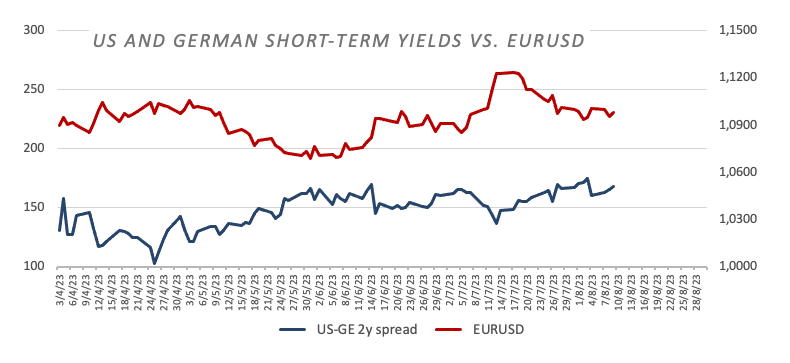- Euro's bullish attempt comes short of 1.1000 vs. the US Dollar.
- Stocks in Europe en route to close the day with decent gains.
- EUR/USD re-targets 1.1000 on improved risk appetite.
- The USD Index (DXY) trims part of the earlier losses.
- Chinese inflation figures surprised to the upside in July.
After experiencing losses in two consecutive sessions, the Euro (EUR) has successfully regained some balance and countered some of the recent pessimism against the US Dollar (USD). As a result, EUR/USD has displayed resilience and is now striving to surpass the significant threshold of 1.1000 on Wednesday.
The improved overall market sentiment, particularly in terms of risk appetite, has exerted pressure on the Greenback, providing an additional boost to the pair in the middle of the week. This occurrence coincides with a period of uncertainty concerning the trajectory of US yields across the curve vs. a marked bounce in the German 10-year bund yields against the backdrop of increased expectation ahead of the release of crucial US inflation data, as measured by the Consumer Price Index (CPI), which is scheduled for Thursday.
Zooming out to consider the overall scope of monetary policy, there haven't been any significant shifts. Market participants are still expecting the Federal Reserve to keep its existing interest rates steady throughout the remainder of the year. On the other hand, the European Central Bank (ECB) is encountering internal disagreements within its Council about whether to persist with its tightening actions post the summer period.
On the front of economic indicators, Mortgage Applications experienced a contraction of 3.1% during the week concluding on August 4, as reported by the Mortgage Bankers Association (MBA).
Daily digest market movers: Euro shifts its attention to the US CPI
- The EUR attempts to challenge 1.1000 vs. the USD on Wednesday.
- The USD Index (DXY) appears well supported near 102.30.
- The risk-on mood underpins the pair’s recovery so far.
- Chinese CPI dropped 0.3% YoY in July; PPI decreased 4.4% YoY.
- CME Group’s FedWatch Tool sees no extra hikes by the Fed in H2 2023.
- Speculation that the Fed might have ended its hiking cycle remains steady.
- Markets look focused on the US CPI due on August 11.
Technical Analysis: Euro's initial hurdle emerges at 1.1041
EUR/USD manages well to attempt a decent rebound and refocus its attention to the key 1.1000 region so far on Wednesday.
Breaking through the 1.0920 range, where the monthly low aligns with the crossing of the interim 55-day and 100-day SMAs exposes EUR/USD to potential downside movement. This could drive spot toward the July low of 1.0833 (July 6). Such a downward move might precede a further decline toward the significant 200-day SMA at 1.0760 ahead of the May low of 1.0635 (May 31). Deeper down lies the March low of 1.0516 (March 15), and subsequently, the 2023 low at 1.0481 (January 6).
In contrast, sporadic bullish attempts could encourage the pair to challenge the psychological 1.1000 mark prior to the so far August high at 1.1041 (August 4) and the weekly top at 1.1149 seen on (July 27). Should this level be surpassed, it might help alleviate some of the downward pressure, potentially motivating the pair to test the 2023 peak of 1.1275 (July 18). Once this threshold is breached, significant resistance levels become less prominent until the peak of 2022 at 1.1495 (February 10), closely followed by the round level of 1.1500.
Furthermore, the optimistic outlook for EUR/USD remains valid as long as the pair maintains its position above the crucial 200-day SMA.
Euro FAQs
What is the Euro?
The Euro is the currency for the 20 European Union countries that belong to the Eurozone. It is the second most heavily traded currency in the world behind the US Dollar. In 2022, it accounted for 31% of all foreign exchange transactions, with an average daily turnover of over $2.2 trillion a day.
EUR/USD is the most heavily traded currency pair in the world, accounting for an estimated 30% off all transactions, followed by EUR/JPY (4%), EUR/GBP (3%) and EUR/AUD (2%).
What is the ECB and how does it impact the Euro?
The European Central Bank (ECB) in Frankfurt, Germany, is the reserve bank for the Eurozone. The ECB sets interest rates and manages monetary policy.
The ECB’s primary mandate is to maintain price stability, which means either controlling inflation or stimulating growth. Its primary tool is the raising or lowering of interest rates. Relatively high interest rates – or the expectation of higher rates – will usually benefit the Euro and vice versa.
The ECB Governing Council makes monetary policy decisions at meetings held eight times a year. Decisions are made by heads of the Eurozone national banks and six permanent members, including the President of the ECB, Christine Lagarde.
How does inflation data impact the value of the Euro?
Eurozone inflation data, measured by the Harmonized Index of Consumer Prices (HICP), is an important econometric for the Euro. If inflation rises more than expected, especially if above the ECB’s 2% target, it obliges the ECB to raise interest rates to bring it back under control.
Relatively high interest rates compared to its counterparts will usually benefit the Euro, as it makes the region more attractive as a place for global investors to park their money.
How does economic data influence the value of the Euro?
Data releases gauge the health of the economy and can impact on the Euro. Indicators such as GDP, Manufacturing and Services PMIs, employment, and consumer sentiment surveys can all influence the direction of the single currency.
A strong economy is good for the Euro. Not only does it attract more foreign investment but it may encourage the ECB to put up interest rates, which will directly strengthen the Euro. Otherwise, if economic data is weak, the Euro is likely to fall.
Economic data for the four largest economies in the euro area (Germany, France, Italy and Spain) are especially significant, as they account for 75% of the Eurozone’s economy.
How does the Trade Balance impact the Euro?
Another significant data release for the Euro is the Trade Balance. This indicator measures the difference between what a country earns from its exports and what it spends on imports over a given period.
If a country produces highly sought after exports then its currency will gain in value purely from the extra demand created from foreign buyers seeking to purchase these goods. Therefore, a positive net Trade Balance strengthens a currency and vice versa for a negative balance.
Information on these pages contains forward-looking statements that involve risks and uncertainties. Markets and instruments profiled on this page are for informational purposes only and should not in any way come across as a recommendation to buy or sell in these assets. You should do your own thorough research before making any investment decisions. FXStreet does not in any way guarantee that this information is free from mistakes, errors, or material misstatements. It also does not guarantee that this information is of a timely nature. Investing in Open Markets involves a great deal of risk, including the loss of all or a portion of your investment, as well as emotional distress. All risks, losses and costs associated with investing, including total loss of principal, are your responsibility. The views and opinions expressed in this article are those of the authors and do not necessarily reflect the official policy or position of FXStreet nor its advertisers. The author will not be held responsible for information that is found at the end of links posted on this page.
If not otherwise explicitly mentioned in the body of the article, at the time of writing, the author has no position in any stock mentioned in this article and no business relationship with any company mentioned. The author has not received compensation for writing this article, other than from FXStreet.
FXStreet and the author do not provide personalized recommendations. The author makes no representations as to the accuracy, completeness, or suitability of this information. FXStreet and the author will not be liable for any errors, omissions or any losses, injuries or damages arising from this information and its display or use. Errors and omissions excepted.
The author and FXStreet are not registered investment advisors and nothing in this article is intended to be investment advice.
Recommended content
Editors’ Picks
EUR/USD stays in positive territory above 1.0850 after US data

EUR/USD clings to modest daily gains above 1.0850 in the second half of the day on Friday. The improving risk mood makes it difficult for the US Dollar to hold its ground after PCE inflation data, helping the pair edge higher ahead of the weekend.
GBP/USD stabilizes above 1.2850 as risk mood improves

GBP/USD maintains recovery momentum and fluctuates above 1.2850 in the American session on Friday. The positive shift seen in risk mood doesn't allow the US Dollar to preserve its strength and supports the pair.
Gold rebounds above $2,380 as US yields stretch lower

Following a quiet European session, Gold gathers bullish momentum and trades decisively higher on the day above $2,380. The benchmark 10-year US Treasury bond yield loses more than 1% on the day after US PCE inflation data, fuelling XAU/USD's upside.
Avalanche price sets for a rally following retest of key support level

Avalanche (AVAX) price bounced off the $26.34 support level to trade at $27.95 as of Friday. Growing on-chain development activity indicates a potential bullish move in the coming days.
The election, Trump's Dollar policy, and the future of the Yen

After an assassination attempt on former President Donald Trump and drop out of President Biden, Kamala Harris has been endorsed as the Democratic candidate to compete against Trump in the upcoming November US presidential election.
